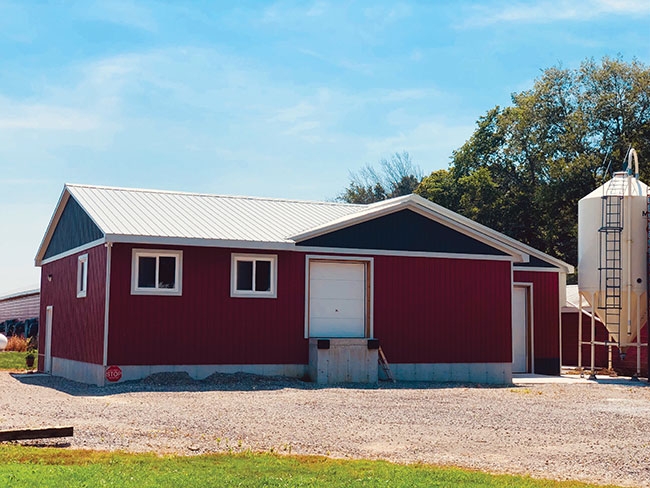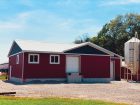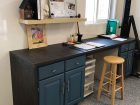
Egg Farmerette: A year after the big build
By Cindy Huitema
Features Blog Profiles The Huitemas made sure the barn’s exterior was esthetically pleasing to visitors and passersby.
The Huitemas made sure the barn’s exterior was esthetically pleasing to visitors and passersby. It’s been just over a year since I, Egg Farmerette, did any writing about our enriched colony housing barn. So, here’s an update on our experiences since our first flock hen placement.
In May, 2018, we gave our first flock of Dekalb hens a new home in the Farmer Automatic Eco II enriched colony housing system. To recap from my previous writings, this housing system caters to the birds’ natural instincts. When describing this housing to urban friends, I would compare it to flying first class or travelling in a limousine.
It includes features such as two perches running the length of each house, curtained and darkened nesting boxes for laying eggs, scratch pads for dust bathing instincts, nail files for scratching behaviour and much more space to roam within each housing unit.
After housing the hens in mid-May, there were still some projects we needed to complete.
Before I go through those, I must comment on my husband Nick’s resourcefulness. Although I knew he was pretty handy during the build and with home renovations (I am sure fellow farmerettes can relate to this!), I am sometimes amazed at how many things he can do. Indeed, he’s earned the nickname MacGyver for his creativity and inventiveness!
Bathroom
Nick worked on getting the bathroom framing finished, having our plumbing apprentice nephew Andrew install a toilet and sink in this bathroom and completing the walls and counter so we would have a functional and clean bathroom space as part of the barn. This was built into some of the ante room space and was always part of our design layout.
Barn exterior
To finish the exterior of the barn, one of the first jobs was to apply vinyl siding. Our son John had a vision for what the outside of the barn should look like since we would see it numerous times every day. It is in plain view from the kitchen window, people can see the barn from the road and that it should be pleasant to look at, he noted.
They got the siding done very methodically and chose which part of the barn to work on based on the location of the sun to avoid working in direct sunlight – you may remember that last summer was extremely hot, humid and dry.
In-floor heating
We had the in-floor heating roughed in at the time the hens were housed in May, but as there was no need for heat in the summer, we could complete this later. As we learned during our previous year of construction, the barn building industry is very busy and you need patience when waiting for their availability. The in-floor heating got finished in December between Christmas and New Year’s after we pressured the installation contractor.
Epoxy coating
During the first week of the placement, Nick and John carried out doing an epoxy coating on the entrance/ante room and bathroom floors. They did this with the Beauti-tone kits from Home Hardware. This was a good first area to do before the packing room floor, which is at least four times more space to apply the epoxy coating to.
The epoxy coating for the packing room floor ended up getting done one year after the barn build completion and after the first flock was finished. In May of this year, John and Charlotte carried out this task, coating 500 square feet. The egg packer and any other items in the pack room had to be removed for this job and the empty cooler proved to be a good place for this.
Office space
We also had put off installing a counter/desk with cupboards until we knew the pack room floor would be completed. We put in two cupboards, a desk area, countertop and floating shelf, making this workspace very functional and aesthetically appealing.
Monitoring
With John back at University of Guelph in his last year studying to achieve his Bachelor of Commerce, it was more difficult for the to-do list to get any checkmarks. However, he took advantage of the Black Friday sales and purchased a TV screen and camera package so that we could have eight different views of the inside and outside of the barn from the pack room vantage point.
The cameras got installed during the Christmas break and are a very valuable tool for barn security, hen care, monitoring the barn via cellphone when we’re off-site and checking on someone working in the barn.
First audit
We had our first third party audit last December. For readers outside the industry, egg farmers must undergo an audit by an audit company from outside of the poultry/agriculture sector. This includes inspecting the barn, housing, hens, hen care, flock and barn records and paperwork, as well as answering any questions that the inspector asks about your operation. Egg farmers are also inspected at least once a year by an inspector on staff with Egg Farmers of Ontario.
Push sweeper
After sweeping our barn floor by hand for a couple months, we invested in a push sweeper to make this task less labour intensive for my daughter, Charlotte, and myself. Our new barn is at least four times larger than our old one, making sweeping a much bigger job.
Forward-thinking
At flock change time in May, after the barn was washed, we poured a cement pad for a fourth row of enriched colony housing. Our goal was to be prepared if the time and need arises in the upcoming year for more space for hens.
All of the above things we did have turned out to enhance our barn routine and barn appearance and have made our workplace a more pleasant and functional place to be.
Both Charlotte and John are keen to participate in the growth of the operation and embrace the technology and new barn routine. Additionally, Nick and I are getting used to the technology and ideas of our next generation of egg farmers. We look ahead to future growth and innovation on our family journey as egg farmers.
Cindy Huitema is an egg farmer from Haldimand County, Ont. In her column, she shares her journey transitioning from conventional hen housing to an enriched system.
Print this page

